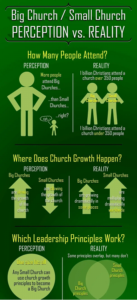Your Church CAN Reverse the Downward Trend | By John Finkelde
Pastors can reverse a church’s decline by adopting healthy habits that promote Christian evangelism, outreach to the community, and spiritual maturity.
Pastors experience deep frustration and confusion when their churches stop growing.
Churches are certainly not alone when it comes to decline.
Many organizations get stuck and decline into maintenance mode, and sadly, even into impotence.
If that were not true, we would never see new organizations starting up with the kind of frenzied activity we see every day around the globe.
What causes this decline?
Are there definitive reasons as to why churches stop growing? More importantly, how do we reverse the downward trend?
7 Negative Habits of Declining Churches (and the Solution for Each)
Churches stop growing when they have an unhealthy focus on growth.
When churches focus on growth as an end, they begin to obsess about numbers and focus on stats.
I’ve been in this unhealthy place.
It leads to comparison with other churches and leaders. The comparison game is most unhelpful when your church has stopped growing.
It is death to your soul as you ride the inevitable roller coaster ride of strong or poor attendance and other indicators, such as people leaving.
As a consultant and coach, my focus is on church health.
While I don’t neglect growth, I don’t see it as an end. Making disciples of Christ is our end goal.
I also refuse to neglect or ignore the need to grow; however, I recognize that every church has an optimum size. This optimum size is determined by a range of factors including demographics, leadership capacity, community connections and so on.
Karl Vaters has become the go-to small church guy. His prolific writings have been influential around the globe.
His infographic below shows that perception can be quite different from reality when it comes to the optimum size for a church.

When churches run with the mantra of “growth, growth, growth, and more growth,” it breeds an unholy discontent with a relatively productive status.
Solution
Conduct a health check on your church.
This will involve analyzing key stats, such as baptism numbers, attendance relative to membership, the percentage of adults serving, and participation in small groups.
Also, check on the spiritual vitality of your key leaders. Healthy leaders will lead you to a healthy church.
A wise consultant or coach can help you conduct the analysis and bring fresh eyes to your church as it focuses on healthy growth.
2. Churches stop growing when they neglect their primary mission.
The primary mission that Jesus has given us is to make disciples in the context of communities of faith.
When leaders and pastors neglect this primary mission, their churches are destined for decline.
There are multiple reasons why this occurs.
⦁ Leaders get distracted by other priorities.
⦁ Pastors become lazy and switch into a maintenance mode, rather than pioneering again.
⦁ Fear of failure can rob pastors of courage and cause them to retreat from their primary mission.
⦁ Leaders can also lose strength through no fault of their own by ill health, tragedy, or fierce opposition.
Whatever the reason, churches decline when they stop turning people into committed followers of Christ.
You may be busy and have squillions of programs happening. However, the hard question to ask is this: Are we making disciples?
Solution
Aligning yourself afresh with your mission doesn’t happen overnight.
It takes careful and often methodical reflection of your current state and a willingness to lead so that change occurs in yourself and your team.
Personal reflection can help.
I often stepped aside from the day-to-day ministry and spent time in reflection.
I found these personal times of thought, prayer, and evaluation to be essential as I considered my core values and primary mission.
Allocating special time to rethink your mission will lead to a healthier church.
You can use simple reflection questions to help you refocus as you consider your key relationships and core values.
I know this process will guide you into a fresh focus on your primary mission.
3. Churches stop growing when hospitality is broken.
This aspect of church life is an obsession for me.
A primary reason many churches decline into impotence is their almost legendary neglect of strangers.
I have written about the multitude of reasons visitors never come back for a second visit.
The Greek word used for hospitality in the New Testament is philoxenia, which literally means love of strangers.
Different New Testament writers admonish us to strengthen this aspect of Christian living; yet I often see ambivalence towards hospitality, or worse still, lip service.
It’s naive to think that people don’t need to be trained in hospitality. They need guidance so they can turn their heartfelt desire to love people into practical realities.
Solution
Train your welcome team to use a simple Visitor’s Connect Card to get a visitor’s contact details and follow up in the most appropriate way for your culture.
Visitor Connect Cards are essential to growing a healthy church.
They give you the means and opportunity to reconnect with a person who is checking out your church. Without them, you have little influence on their decision to return for a second visit.
Some leaders think that visitors want to be left alone, that they don’t want to be asked about their reasons for visiting, or that they don’t want to give out their contact information.
While it is true that some visitors don’t want further contact, most are on the opposite end of the spectrum. They have come to check out your church, and they want to make the connection.
Use a Visitor’s Connect Card to help them start the journey and join your church community.
4. Churches stop growing when they seem dated and irrelevant.
Today’s traditions were once groundbreaking, breathtaking new initiatives.
The organ once reviled as the devil’s instrument became the bastion of church worship.
The now iconic Eiffel Tower was once derided by Parisians.
If we guard our traditions too fiercely, we can get trapped in a time warp. We become irrelevant. We lose our edge.
Being relevant is not just about programs or attitudes. It applies to the way the church looks and feels. Think about the look of the church with its furniture, style, and color scheme. We must couple our preferences with biblical values if we are to continue to see our churches grow.
I know that some people get quite upset with any focus on outward things. Paint color doesn’t seem important in the context of true worship or following Christ.
However, while God looks on the heart, we are designed to notice the world around us. When churches neglect the “non-essentials,” there’s a disconnect. It sends a message that the church’s leaders aren’t paying attention to changes in the culture, or they don’t care about beauty.
Solution
Audit your building. Ask yourself a few questions:
⦁ How old are the styles, colors, and furniture throughout the campus?
⦁ Do visitors see chipped, worn-out furniture? Is anything broken? (Old furnishings can send a message of neglect to visitors.)
⦁ What do visitors see when they enter the building? Is there a welcome station nearby? Is the foyer clean and well-lit, or is it unkempt and gloomy?
⦁ Does the foyer need artwork here and there? Are there examples of beauty that could inspire people to worship God?
If you need a refresh, do it. If you need an overhaul, start planning.
5. Churches stop growing when they get too comfortable.
We all want to enjoy the God’s blessings, but the truth is, prosperity can make us complacent.
The more comfortable we are, the more we stand to lose. Change is risky, so we’re less likely to “bet the farm” on innovation and exploration.
Minimizing risk becomes paramount.
We try to maintain our kingdom, rather than exploring uncharted territory.
We pave well-worn roads, rather than forging new paths.
We till our own field, rather than ploughing new lands.
The elders at our church handed the ministry over to Next-Generation leaders because we wanted to step into new arenas of risk. As a result, we discovered an important truth: Christ is faithful — all the time. We also realized that our willingness to trust Him gives the Lord immense pleasure.
Solution
Take a risk. Follow the voice of the Holy Spirit as He leads you into uncharted waters.
In Romans 16, Paul praises Priscilla and Aquila because they risked their lives for his sake. “Safety-first” attitudes don’t build the church.
We are called to walk by faith, not by sight. Where is God prompting you to take a risk?
6. Churches that stop growing are not “optimized” for growth.
Churches, like individuals and companies, can reach their optimum size.
Discovering the optimum size of your church is not an easy task because your church’s size is determined by a complex range of factors.
There’s the energy of the pastor, the demographics of the area, the capabilities of your congregation, the recent history of your church, and more importantly, the sovereignty of God.
Understanding “optimal growth” helps leaders strategizes the church’s outreach. It empowers leaders. It encourages them to have a courageous heart and an inquiring mind as they discern their optimum size and maximize their capacity.
Solution
Discuss this point with your key leaders and consider how you can optimize your church.
Your church’s mission, context, and capacity will determine the optimum size.
The call your church has received is a sovereign assignment from the Lord. It is His church. You have the privilege of discovering His plan and implementing it. Go with it.
Then, consider your church’s context. Although context may change over time, the shifts will occur gradually. By understanding the context, you can tailor your church’s outreach to the community. Ask yourself these questions:
⦁ What is your church’s demographic? Do you have a wealthy congregation, or are people struggling to meet their needs?
⦁ Is your church ethnically diverse?
⦁ Are you located in high-density area, or is it a low-density area?
⦁ What’s the median age?
⦁ How does traffic flow to, from, and around your church?
Finally, consider your church’s capacity to serve. You may not be able to control your church’s context, but you can control its capacity to minister to people in grace and wisdom.
Try to enlarge your church’s capacity to love. Seek to handle problems in a mature way. Grow together in Christ. Recruit volunteers and develop leaders. Train people and allow them to express their gifts.
7. Churches stop growing because of poor pastoral leadership.
Yes, you read that right.
Poor pastoral leadership can prevent a church from growing.
In 1 Corinthians 12:28, Paul says that God placed apostles in the church first.
Apostles have been sent. They motivate people to move. They refocus the church when she strays from her priorities, namely evangelism and discipleship.
A church’s priority is to reach out to lost people and share the love of Jesus. Then, she should help people grow spiritually as they begin to integrate into the community of faith.
Some pastors are gifted teachers, and they naturally lean towards pastoral care and godly instruction — to the exclusion of evangelism.
My natural bent was towards teaching the Word and discipling leaders, and for a while, I neglected evangelism.
I had to intentionally move towards evangelism to ensure that our church was bringing lost people to Christ and assimilating them into our community of faith.
Sheep follow their shepherd. If a pastor has a heart for evangelism, the sheep will, too. If a pastor does not value evangelism — and if he doesn’t model it personally — then his people won’t value it either, and the church will decline.
The Challenge for Small Churches
I am a fan of churches of all sizes. In fact, churches are like t-shirts, we need all sizes.
However, as Karl Vaters rightly notes, being small is not a problem, virtue, or excuse.
Some small churches wrestle with inferiority and failure because of their size. They think that being small is a problem to be solved, rather than an option to be optimized.
By contrast, other small churches take unwarranted pride in being small. They accuse larger churches of compromised, shallow teaching.
Being small is not an excuse for inactivity. If you pastor a small church, step out in faith. Do not resist change; instead, maximize your situation.
Jesus preached the Kingdom of God. He encouraged people to trust and follow Him, whether they felt adequate or not. Then, He died on the cross and rose again to set them free from the grip of sin and death. He expects us to trust and follow as well. Together, we advance the Kingdom and build His Church.
Solution
Find a pastor or leader who is gifted in an area in which you lack confidence and ask them to coach you.
Personal coaching is one of the most potent methods of bringing change because it is customized and relevant. Coaches help you begin to see your church with fresh eyes.
They can help you avoid pitfalls and encourage you to focus on the things that grow a healthy church.
If your church has stalled, or if it has started to decline, identify the destructive habits; then, formulate a plan to tackle them one by one, until you have made course corrections.
Enlist the help of wise elders in your church, as well as other pastors in your community.
Get additional training if you need it, then persist.
It takes years to develop bad habits, and it will take time to replace them with healthy ones. The effort is totally worth it, though, as you see your church start to grow and thrive.






